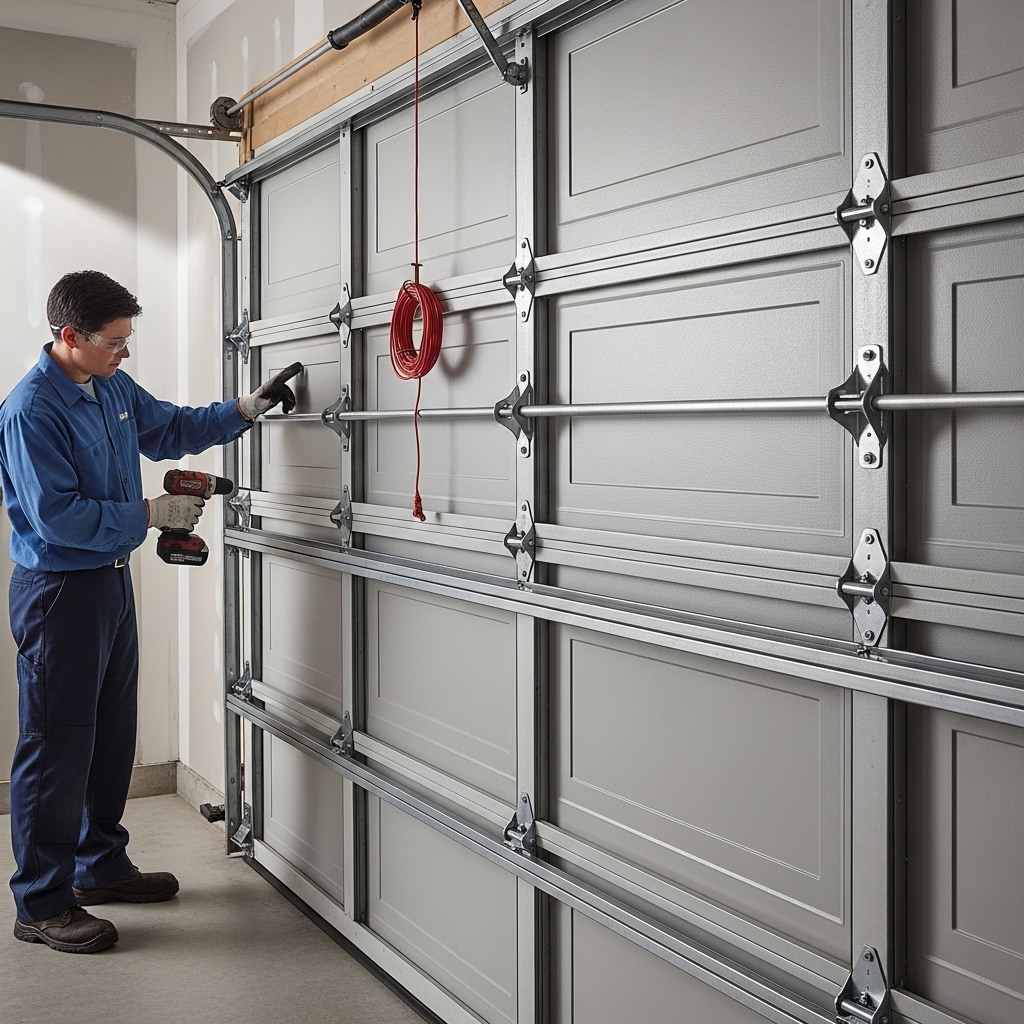Introduction: Make Hurricane Readiness Routine
Florida’s hurricane season places unique pressure on garage doors, which can be the largest single opening in a home. When properly maintained and reinforced, a compliant door helps protect your structure from wind, water, and debris. When neglected, it can become a weak point that allows pressurization and damage. Preparing early and maintaining consistently are the most reliable safeguards. This guide explains how to verify wind-load compliance, inspect structural connections, test manual operation for power outages, and set up a practical timeline for pre-season, mid-season, and post-storm maintenance. If you prefer expert help confirming balance, bracing, and calibration before the storms arrive, schedule preventive garage door maintenance to ensure every component is ready.
Your goal is a door that moves smoothly, seals tightly, resists wind pressure, and can be operated safely by hand during outages. Achieving that goal requires attention to reinforcement, hardware integrity, weather seals, safety systems, and opener readiness. With a structured plan, you can reduce risk and recover faster after severe weather.
Confirm Wind-Load Compliance
Start by verifying that your door meets local wind-load requirements for your region of Florida. Compliance involves both the door design and the bracing system. Look for installed reinforcement struts across the interior of the door sections; these prevent panel deflection. If your home relies on removable braces, make sure all hardware is present and the mounting points are in excellent condition. If you are unsure about your door’s rating, consult documentation from the manufacturer or a qualified professional to evaluate and update the system as needed. An under-rated door is vulnerable even if it looks sturdy.
Pre-Season Inspection Checklist
Well before the first named storm, complete a top-to-bottom inspection. Check the vertical and horizontal tracks for straightness, secure bracket fasteners, and any signs of movement in the wall anchors. Inspect rollers for smooth rotation and bearings free of rust. Evaluate hinges for tightness and hairline cracks at the knuckles. Confirm the torsion shaft spins freely in its bearings and that drums are secure on the shaft. Inspect lift cables near the bottom brackets and drums for signs of fraying or crushing. Look at the opener’s header bracket and ceiling mounts; both should be rock solid with no wobble. Finally, verify that perimeter weather seals sit flush with no daylight showing when the door is closed.
Lubrication and Corrosion Control
Florida humidity demands careful lubrication. Apply a light, garage-door-specific lubricant to hinge pins, roller bearings, and spring bearings, and wipe away the excess. Silicone-spray the weather seals so they remain pliable and less likely to stick in hot weather. If you live near the coast, consider a light anti-corrosion film on exposed metal like fasteners, the torsion shaft ends, and bracket edges. Do not lubricate the track channel; keep it clean and dry to prevent grit buildup that causes binding under stress.
Manual Operation and Power Outage Readiness
Hurricanes often cause outages. Test the emergency release when the door is closed so you can disengage the opener quickly. Lift the door by hand and confirm it moves smoothly and remains manageable at mid travel; if it wants to slam down or rocket upward, the spring balance is off and needs professional adjustment. Reconnect the opener and verify safety reversal by closing on a 2×4 laid flat on the floor. If your opener supports battery backup, test it now by unplugging the unit briefly.
Sensor Reliability in Storm Conditions
Photo-eyes protect people and pets by reversing the door if the beam is interrupted. Clean the lenses, check alignment, and confirm that indicator lights stay solid. Consider the effect of heavy rain and debris near the floor—keep the area around sensors free of storage and ensure they are mounted firmly. Sun glare can also cause false trips; adjust or shade sensors if afternoon light interferes.
Reinforcement Struts and Bracing
Inspect reinforcement struts across each section to ensure they are straight and tightly fastened. If your door uses removable braces for storm events, practice installing them before a storm is imminent. Confirm that fasteners are present, threads are not stripped, and brackets are not cracked. Label the hardware and store it in an accessible spot. Reinforcement is not just about withstanding wind; it also helps the door resume normal service without panel warping after the storm.
Perimeter Seals and Water Management
Intense wind-driven rain seeks every gap. Inspect side and top seals for pliability and snug contact against the door. Replace brittle or shrunken rubber, and clean the mating surfaces so the seals can do their job. For the bottom seal, remove sand and debris that prevent full closure. Consider a taller bottom seal profile if your slab has settled and a gap remains. Good sealing reduces water ingress and protects items stored near the threshold.
Mid-Season Tune-Ups
Midway through hurricane season, repeat core checks: track alignment, bracket tightness, roller condition, weather seals, and opener calibration. Verify that nothing has shifted after windy periods. If the door sounds louder or moves less smoothly, re-lubricate pivot points and inspect for developing rust. If you need specialized attention—like spring balance verification or bearing replacement—invite professionals familiar with local wind codes to validate your setup. To maintain confidence through the peak months, combine your routine with expert garage door maintenance focused on storm readiness.
After-Storm Inspection Protocol
Once conditions are safe, inspect the entire system before returning to daily operation. Look for bent tracks, shifted brackets, or signs that the door scraped the track under stress. Check panels for dents or creases that indicate wind pressure exceeded reinforcement in spots. Rinse salt residue from hardware with fresh water and allow to dry, then re-lubricate hinges and bearings lightly. Test manual operation again; if the door binds or feels heavier, components may have moved during the storm. Address problems promptly to prevent further wear.
Noise Control During Heavy Weather Cycles
Storm periods can introduce new noises as sand, salt, and moisture intrude. Persistent squeaks after lubrication often point to worn roller bearings. Scraping suggests track misalignment. Rattling can indicate loose support angles for the opener or reinforcement struts that need snugging. Track movement under load is a red flag; tighten mounting hardware into solid framing. The quieter your door is, the more likely it is to be aligned and healthy.
What Not to Do
Do not brace the door with improvised lumber that interferes with travel or puts pressure on the opener arm. Do not disable safety sensors to force operation during a storm. Do not attempt to adjust springs or cables yourself; tension components require trained tools and techniques. Avoid heavy grease that traps grit in humid air, and never ignore frayed cables or cracked hinges.
Creating a Hurricane Season Maintenance Timeline
Six to eight weeks before the season, complete your full inspection, replace worn seals, and verify reinforcement. Two to three weeks before peak months, perform a light lubrication, test manual operation, and confirm sensor alignment. After each major storm, rinse, re-lubricate, and inspect alignment and hardware. Keep simple records so you can compare noise levels, balance feel, and component wear over time. Consistency is the secret to reliability.
Frequently Asked Questions
Q: How do I know if my door is wind-rated? A: Check documentation or labels from the manufacturer, or consult a local professional. Wind-rated doors often include reinforcement struts and specific hardware to meet code.
Q: Should I open the door during a storm to relieve pressure? A: No. Keep the door closed and braced per your system’s design. Opening during high winds is dangerous and can damage the door and structure.
Q: What can I do if power fails and my car is inside? A: Use the manual release when the door is closed, then lift by hand. If the door is too heavy or won’t stay put, the springs are out of balance—seek professional help.
Q: How often should I replace weather seals in Florida? A: Inspect quarterly and replace when they get brittle, cracked, or leave gaps. In hot, sunny climates, seals wear faster than in cooler regions.
Q: Can I lubricate the tracks to help in wet weather? A: No. Keep tracks clean and dry. Lubrication attracts grit and causes binding.
Q: Is battery backup worthwhile? A: Yes. Battery backup keeps your opener functional during outages common in hurricane season, improving safety and convenience.
Stay Ready, Not Worried
Start early, maintain consistently, and verify reinforcement and safety systems before storms arrive. If you want expert confirmation that your door is balanced, calibrated, and structurally prepared, schedule trusted garage door maintenance and face hurricane season with confidence.

